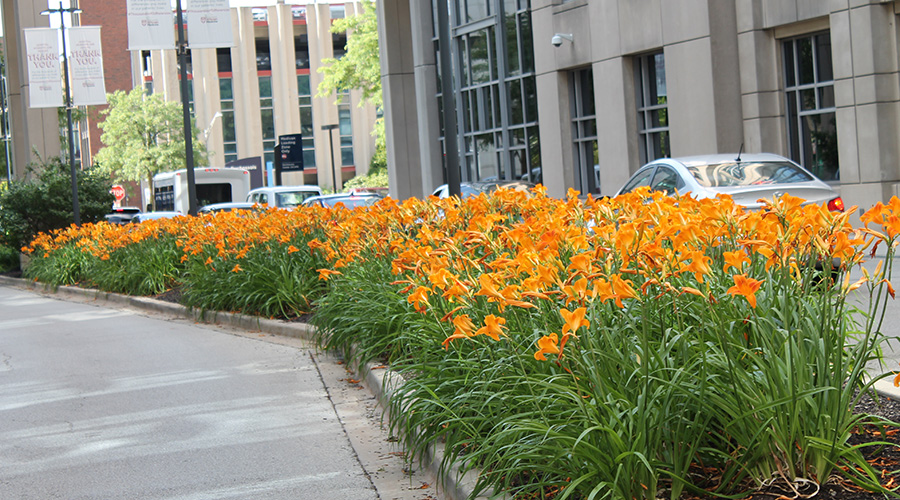Putting More Green in Grounds
Managers offer proven strategies for maximizing environmental friendliness in all areas of operations
Landscaped areas are becoming increasingly important parts of organizations’ efforts to minimize their environmental impact. As a result, managers responsible for grounds care operations must understand the landscape’s role in helping organizations achieve this goal.
Organizations interested in reducing their facilities’ environmental footprint have many reasons to increase their focus on grounds management programs. The first important point to consider is that landscaped areas and general grounds usually account for the majority of a site’s total square footage. Also, all of the precipitation a facility campus receives eventually runs from its grounds into the environment.
Grounds maintenance work also is much more visible than other work going on in and around facilities, so it becomes clear few other functions receive such levels of public scrutiny.
“Everyone sees us doing our work, including the surrounding community,” explains Kevin Yeiser, director of grounds and athletic facilities at Lebanon Valley College in Annville, Penn. “If we can reduce the number of times an operator makes a pesticides application wearing a suit and respirator, the fewer concerns there will be about what we are doing to the environment.”
Grounds operations also play an important role in helping organizations qualify for the Leadership in Energy and Environmental Design (LEED) certification from the U.S. Green Buildings Council.
The Prime Suspects
Grounds maintenance practices can minimize a facility’s environmental impact the most by: reducing pesticide applications; maximizing irrigation system efficiency, erosion control and storm-water management; and using the most appropriate landscape materials.
“Controlling site-drainage and storm-water runoff are key areas in reducing environmental harm,” says Greg Nichols, assistant director of facilities for grounds with Bryn Mawr (Penn.) College. Collecting and controlling the recharge of storm water through a retention pond has paid huge environmental dividends for his facility.
Also, maintaining healthy and well-kept turf and planting beds can help filter storm-water runoff, and controlling runoff can significantly reduce erosion.
With many institutional and commercial organizations’ growing focus on saving water and the harmful effects of runoff, managers need to take a careful look at a site’s irrigation system. Using high-efficiency irrigation technology greatly reduces potable water use for irrigation, in comparison to conventional means of irrigation.
For most large grounds programs, improving irrigation efficiency has the greatest potential for saving water. In a typical site with sizeable areas of turf and landscaping, extra attention to irrigation system design, maintenance and management will reduce water use by 25-75 percent.
One of the best ways to improve an irrigation system’s efficiency is to perform an audit. Such an audit documents existing sources of water waste and recommends steps to reduce the use and costs of irrigation systems.
Detailed inspections record specific sources of water waste, including: improper design elements and hardware selection; faulty or disabled system components; poor water distribution uniformity; and inappropriate irrigation schedules.
Rethinking Pest Control
While some of these items can have a large environmental impact, managers can implement several of them relatively simply and inexpensively.
For example, integrated pest management (IPM) uses common-sense strategies to reduce sources of food, water and shelter for pests in buildings and in landscaped areas. IPM programs take advantage of effective pest management strategies and call for using pesticides only when the target pest has reached an unacceptable level, as opposed to using a general cover spray. Adopting IPM techniques comes down to educating personnel and applying important lessons.
“This was really a cost-effective strategy for us,” Yeiser says. “There was no special equipment or materials to purchase. We’ve seen a measurable reduction in pesticide usage, which was very green-friendly, not only to the environment but also in the wallet.”
Adds Nichols, “A lot of these concepts are all tied together in various ways. For instance, wise plant selection is a key to minimizing the need for pesticides, irrigation and other resources.”
Selecting the right plants for a facility’s landscape usually means opting for native or adapted plants. Such plants either are indigenous to an area or are cultivars of native plant materials that have adapted to the climate and are not considered invasive species or noxious weeds.
Once established, these plants require limited irrigation water for sustenance and do not require active maintenance, such as mowing. Using such plants also provides habitat value and promotes biodiversity by avoiding monoculture plantings.
Benefits of Training
A well-trained grounds staff also can help managers in successfully selecting and maintaining indigenous plant species for site restoration and landscaping.
Such landscaped areas not only help reduce water use and waste. They also can reduce heat islands, in which urban areas are hotter than rural areas by 15 degrees. Removing excessive paved areas and replacing them with landscaped areas, or replacing excessive turf-grass area with natural landscape features also can help diffuse this occurrence.
Trees can reduce the temperature of nearby areas by up to 20 degrees, and landscaping can divert air into building windows to increase circulation. Over large areas, the installation of such smart landscape features can significantly offset the heat-island effect.
Several simple fixes also provide benefits that can add up quickly.
“Some low-hanging fruit would (include) having equipment serviced properly and operating efficiently, eliminating wasted and unnecessary travel time with better job planning, and grass cycling and leaf mulching on site where possible,” says Joseph Jackson, CGM, assistant director of facilities management with Duke University in Durham, N.C.
Similar quick fixes include limiting the use of gas-powered equipment to essential tasks only, testing soil to focus on steps that will make plant material less susceptible to insect and disease problems, and creating a composting program with green wastes from mowing and leaf collection.
Leading the Charge
An organization’s grounds management department traditionally has served as its environmental steward. As head of this department, the grounds manager’s job is to urge the organization to recognize and accept its responsibility to conserve, protect and treasure natural resources.
Managers can fulfill this responsibility by working to establish a green philosophy within the organizational strategic plan and to push to institutionalize as many green initiatives as possible. This process involves educating both those within the organization and those in the surrounding community.
“Raising awareness in regard to the effects of maintaining the landscape on the environment is key to getting the organization to think green,” Jackson says. “This thinking eventually positions the organization as a responsible corporate citizen within the larger community.”
In the same vein, managers can improve overall green efforts by hiring employees or contractors based on their awareness, attitude and commitment to environmental stewardship. Equally important is getting maintenance employees to buy into such initiatives by including them in the planning process.
Says Nichols, “A good way to get to get them involved and invested is by challenging your grounds professionals to incorporate environmental stewardship practices into their grounds management plan.”
Eric Grammer is communications and marketing manager with the professional Grounds Management Society.
Spotlight: Professional Grounds Management Society
The Professional Grounds Management Society (PGMS) was established in 1911 as a professional society for the individual with the purpose of education and professional advancement.
Most PGMS members are institutional grounds managers who work for organizations such as colleges, universities, municipalities, park and recreation facilities, office parks, apartment complexes, hotels, motels, cemeteries, and theme parks.
PGMS offers a range of activities and resources designed to address the needs of members. Among these resources is a certification program.
For those interested in becoming a Certified Grounds Manager (CGM), there is a very specific prescribed procedure. A candidate must meet one of the three criteria below:
• A bachelor of science in a recognized green industry field, including management, and four years of experience in the field of grounds maintenance, of which two years are supervisory.
• A two-year degree from a recognized college or junior college, and six years of experience in the grounds maintenance field with a minimum of three years of supervisory experience.
• Eight years in the grounds maintenance field, with a minimum of four years of supervisory experience.
The examination process consists of two parts.
The first part is administered by an approved proctor and covers a core of basic principles of grounds management, consisting of 100 true-or-false and multiple-choice questions.
The applicant taking the examination is required to answer these particular questions without referring to notes or reference materials. A minimum passing grade of 70 percent is required.
The closed book test contains questions on: insects and diseases; soils; trees and shrubs, turfgrass; chemicals and fertilizers; and management.
The second part is the open-book exam. This is a newly revised take-home examination to be completed by the applicant based on personal experience and the local situation. Candidates have one year to complete this open-book test for review by the committee.
Topics on the open-book test include: site inventory; operations Inventory; turf management; trees, shrubs and ground covers; irrigation; pavings; management skills; and budgets and finances.
Application and examination fees for PGMS members is $150. Candidates also can join PGMS and apply for the program simultaneously by paying $300.
For more information on certification, as well as other PGMS resources and activities, visit www.pgms.org, or call (800) 609-PGMS (7467).
|
Related Topics:











